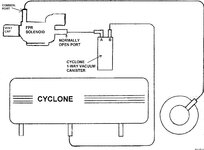ErikTande
Supporting Member
- 1,508
- 569
- Dec 17, 2012
-
Centennial,
Colorado
I picked up a cyclone off of craigslist for $40, and I need some help with setting it up.
I know I need to pick up one of these from a dodge dealer: Vacuum check - 4677204
And from what I read, I can activate it with a fpr solenoid and ECMLink right? How do I do this? I searched but I couldn't find anything with specific details. (I need step by step basics, I'm a newb )
)
Thanks!
Here's a pic, I'm currently cleaning it (it's CAKED with a layer of oil sludge on the inside). Gasoline is taking care of that pretty easily I'll be making new gaskets with a gasket roll.
I'll be making new gaskets with a gasket roll.
I know I need to pick up one of these from a dodge dealer: Vacuum check - 4677204
And from what I read, I can activate it with a fpr solenoid and ECMLink right? How do I do this? I searched but I couldn't find anything with specific details. (I need step by step basics, I'm a newb
 )
)Thanks!
Here's a pic, I'm currently cleaning it (it's CAKED with a layer of oil sludge on the inside). Gasoline is taking care of that pretty easily
 I'll be making new gaskets with a gasket roll.
I'll be making new gaskets with a gasket roll.
You must be logged in to view this image or video.
Last edited:

















